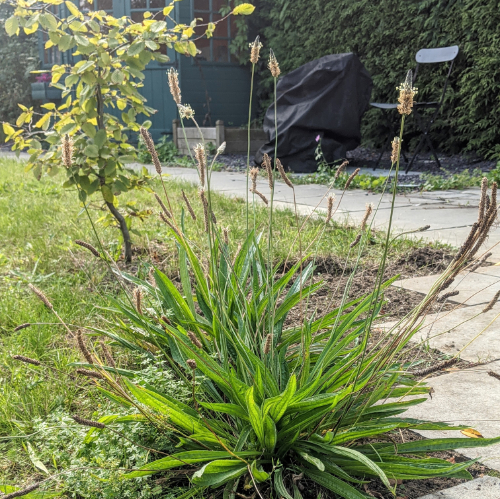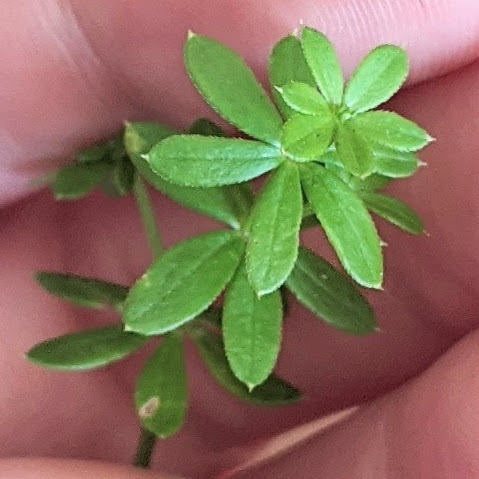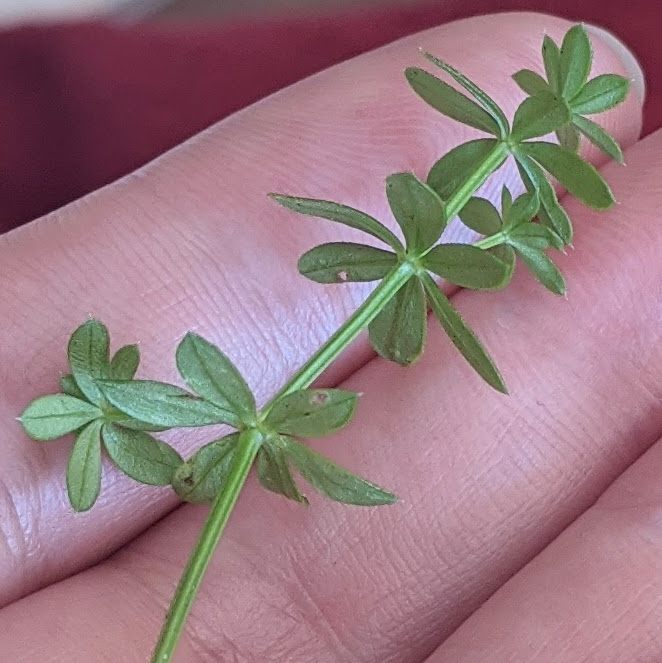
While we’ve been stuck at home, we’ve been enjoying the opportunity to finally get on with some bits and pieces in the garden. One of those bits and pieces is digging out a flowerbed around the little hornbeam tree. I rescued it from the Sale section at the local garden centre when it was little more than a sad stick in a pot and, apart from not enjoying the recent heatwave, it’s now almost knee high which is very pleasing. Paul started clearing away the grass in that area on a day when I was at work, and I came home to find that he’d left a large ribwort plantain (Plantago lanceolata) and some bedstraw because “they looked happy”. Bless him. But it definitely shows that plants are only weeds if you decide they are. If you’re happy and they’re happy, then there’s no problem!
However, it turns out that, when you’ve been hanging about with botanists for a couple of years, just knowing that “it’s a bedstraw of some kind” isn’t good enough.
Recently one of my neighbours has been clearing out her late partner’s books, and I took the opportunity to offer a new home to some botany and more general biology textbooks. Which is how, on Saturday afternoon, I found myself grovelling about on the lawn with copies of Stace and Rose, trying to figure out exactly which bedstraw I was looking at. Thankfully Stace comes with an expansive glossary, because frankly I had absolutely no idea what I was reading without a little help!
Help came, as it so often does, from Twitter, where professionals including Dr Jonathan Mitchley (Reading’s Associate Professor in Field Botany) identified it as being Hedge Bedstraw – specifically, Galium mollugo.
Turns out it’s edible (I tried a little bit – it just tastes… green), of interest medicinally for epilepsy and ‘hysteria’ (research ongoing) and, like other plants in the bedstraw family, it smells lovely as it dries. The vanilla-like scent is produced by coumarin – which is also what gives the plant its medicinal effects. As if that wasn’t enough, the roots can be used to make a red dye not unlike that of madder (Rubia tinctorum), and it can also be used in cheese making. (Two of its older common names are Curdwort and Cheese-renning.)
Because I now have my own facsimile copy of Gerard’s Herball (1633 edition – and yes, I’m still extremely excited about that!), it was easy to look up what Gerard (and Johnson) had to say about it.

A digital copy, from which this image is cropped, is available from archive.org.
It’s listed as Gallium album, and named simply ‘Ladies Bedstraw with white floures’. The name Mollugo is also given, as is the comparison with Madder. According to Gerard:
The people in Cheshire, especially about Namptwich, where the best cheese is made, do use it in their Rennet, esteeming greatly of that cheese above other made without it.
A tiny bit of bias may be sneaking in here, as Gerard himself was from Nantwich!
Interestingly, Gerard also declares that,
We find nothing extant in the antient writers, of the vertues and faculties of the white kinds but are as herbes never had in use either for physicke or Surgerie.
Both quotations from Gerard (1633), pages 1126-8
Several uses are given for the yellow-flowered Lady’s Bedstraw (Galium verum), including an ointment for burns, and the staunching of blood. That seems unlikely, given that coumarin is an anticoagulant, but Gerard takes this piece of information directly from Dioscorides, which would certainly have given it authority.

A digital copy, from which this image is reproduced, is available from archive.org.
(And while we’re questioning Gerard’s accuracy, on page 1128 of the 1633 edition, Thomas Johnson points out that Gerard had originally included an incorrect image in the 1597 edition, illustrating Gallium album minus of Tabern (TaVern?) instead of (sic) Gallium rubrum.)
I’m not entirely sure what I’m going to do with this information now that I have it… my daily medication is contraindicated with coumarins, so I won’t be making myself cups of bedstraw tea or eating bedstraw salad any time soon. Perhaps I could avail myself of some goat’s milk, and try to make cheese? This bedstraw rennet recipe, from Monica Wilde, looks easy enough for me to follow!



